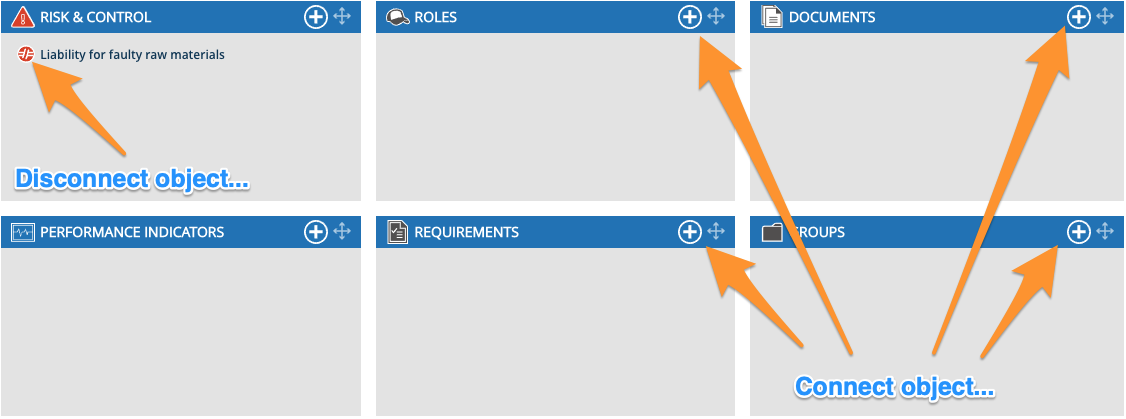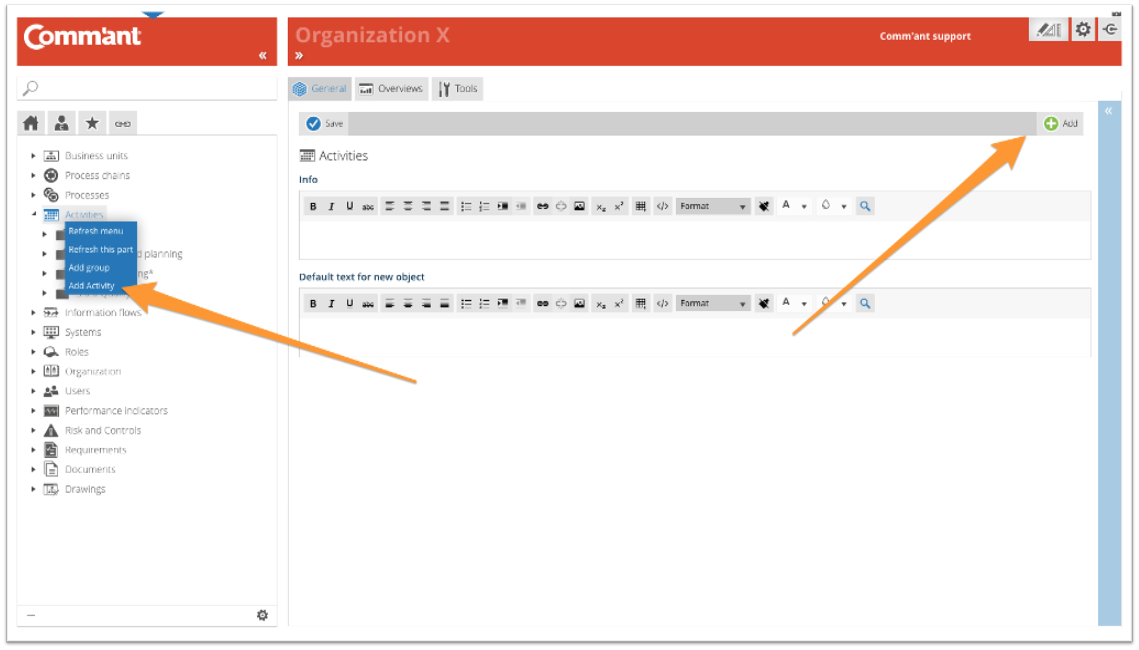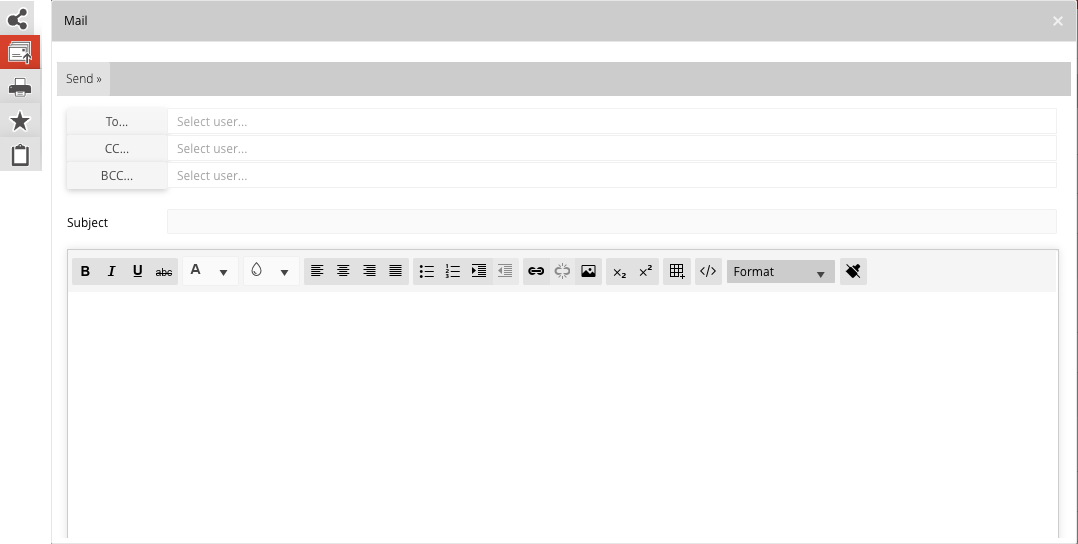Capture activities
The various Activities are added via the Process (see below), or via the Navigation menu. It is possible that you do not immediately see the Activities in the Navigation menu (this depends on the settings in your system), you can make them visible via the button at the bottom left: ![]()
When creating a Process, Activities have usually already been created; after all, a Process consists of a number of related Activities. These Activities can be found via the Navigation menu in a folder under Activities.
To create or modify Activities, make sure you are in Develop Mode via the switch ![]() in the Application bar (right behind your Username).
in the Application bar (right behind your Username).
Edit an Activity created within a Process:
Locate the Activity in the group folder under Activities in the Navigation menu (Comm’ant automatically sorts the folders and their contents in alphabetical order). Select the Activity you want to edit with the left mouse button. On the Main screen, the relevant Activity is opened and you can modify it. The content of the steps is similar to: “To create a new Activity from the Navigation menu”, see below.
Create a new Activity from the Navigation menu:
Step 1
Select Activities in the Navigation menu, right-click, and select “Add activity” or click “Add” in the top right corner of the Main screen. Create the Activity with at least the name by entering it in the “Activity name” field. Give the Activity a clear and unique name, preferably using a verb, as this emphasizes that an activity is being performed.
Step 2
Add more information and save when you are done using the “Save” button at the top left:
- Fill in the Description Describe the content. If you want to go into details, decide whether these details should be clarified here or at a lower level. Extended descriptions can also be added as a document. You can refer to the document in the Description.
- Add Remarks. Write specific comments here, especially during development and changes to the system. When you use special characters, such as @@ in combination with your initials and followed by a comment, you can easily find your comments with the search function, follow up and complete the work.
- With Type, you indicate which type of Activity it concerns. Here you can choose from a pull-down menu, for example, Normal activity, or Decision activity. The Decision type is used for Activities in which decisions are made. The chosen type affects the display of the Activity in the process diagram; a decision icon is added and the color of the Activity block changes.
- The Revision field automatically shows the save date and time.
- With Valid until you indicate when the content of the object must be reviewed. Comm’ant automatically assigns the current date plus one year to this field. This date can be changed if the period of validity ends on another date. Passing the date will not change the display. An overview of the objects whose date is about to expire or have expired can easily be created via a report.
- The Validated checkbox ensures that the newly created object is validated. If this box is not checked, the object will keep the encoding “Not validated” in the system. The advantage of this is that you can make an extra check on your recent additions in Comm’ant. You can generate an overview based on the status “Not validated” to show all changes and then go through them again, reviewing them for consistency and correctness before validating them. Validate the object by ticking the checkbox.
Step 3
After saving, you also have the option to complete the Activity with connections to other objects: Groups, Roles, Documents, Performance indicators, Risk and Controls, and Requirements.

These can be existing or new objects. Existing objects are displayed in the connect boxes. You can create new objects right here via the plus sign in the top edge of the connect box. It is possible to disconnect existing connections using the red unlink icon.
- When you connect the Activity to Roles, you are connecting the Roles and the Organization that were formalized for this Activity. It is common to connect a Function to the Input and Output. This keeps the process diagram simple and the specific responsibilities on the Input and Output are fixed. For example, if no Input or Output is associated with an Activity, the Role “task performed by:” can be associated with an Activity, followed by a link to the appropriate Organization/position.
- When you connect the Activity to Documents, you add links to files or shortcuts. Select an existing document or create an object for a new one.
- When you connect the Activity to a Group, it will be displayed in the Navigation menu in the folder of this Group, or you will find the Activity in the folder “Not classified”.
- You can connect the Activity to Performance indicators to specify where the performance is measured and reported. Select an existing Performance indicator, or create a new one via “+ New”. Confirm your choice with “Save”.
- You can connect the Activity to Risk and Controls. Select an existing one or create a new one via “+ New”. Confirm your choice with “Save”. Later you can easily generate an overview of the risks and their control measures.
- You can connect the Activity to Requirements to determine the relationship with internal or external policies and standards. This relationship explains which rules, regulations, or standards apply. What an employee should know or consider when creating or processing this information. Conversely, the link explains where you can find evidence of proper application of the specific policy, rule, or standard. Select an existing one or create a new one via “+ New”. Confirm your choice with “Save”. You can later easily generate overviews that show where the various Requirements are secured.
Note: The changes in the text and date fields are saved via the “Save” button, other changes such as creating or deleting links are immediately updated; it is not necessary to save them explicitly.
To change an Activity:
To be able to modify Activities, make sure you are working in Develop Mode via the switch in the Application Bar.
When you select an Activity in the Navigation menu with the left mouse button, you immediately have the possibility to change it.
You can save the changes via the “Save” button.
To delete an Activity:
When you delete an Activity, all links it has had to Processes and the possible links to Input and Output will be deleted. The Processes will lose the Activity and the links to the Input and Output. The other sub-objects, such as Organization and Documents, remain in the system.
An Activity can be deleted by clicking on “Delete”. You will first receive a confirmation request before the Activity disappears. Deleting is irreversible.
Inform the Users:
When you make significant changes, you may notify affected Users. You can do this efficiently via e-mail via the “Mail” button in the top right corner of “Share”.
When changing one Activity, you can decide whether to inform all Users related to the entire Process, or only the Users associated with the Input and Output of the Activity.



